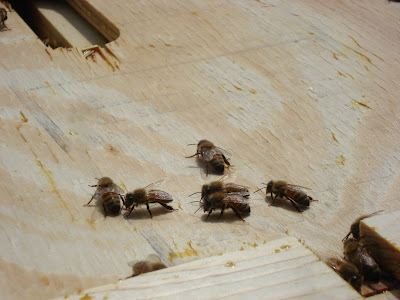 We planted hard red winter wheat as a cover crop in 3 of our beds (on the right in the picture above) this year. Cover crops are an important part of organic agriculture: they add nutrients back into the soil, prevent nutrients from leaching out of the soil, and, keep the soil in place. In the spring, we will turn them under, where they will decompose back into dirt.
We planted hard red winter wheat as a cover crop in 3 of our beds (on the right in the picture above) this year. Cover crops are an important part of organic agriculture: they add nutrients back into the soil, prevent nutrients from leaching out of the soil, and, keep the soil in place. In the spring, we will turn them under, where they will decompose back into dirt.The wheat was provided by Sarah Kavage's project Industrial Harvest. In it, she distributed 1000 bushels of hard red winter wheat to the Chicago community, for free. She says, In short: "Industrial Harvest is an artistic gesture of Herculean proportions about nourishment, food systems, and the City of Chicago. " Read a bit about her project, it's quite inspirational and informative. Question the role of wheat in our society, think about it's connections to the past, the present, your life, and the future. Ponder how this staple crop that was once grown by individuals is completely detached from any individual in the nation's food system. It's quite a fascinating staple crop to be sure. The biggest part of the Industrial Harvest is the connection of the impersonal wheat purchase directly to the community of the people of Chicago. The wheat that she gave away is to be used to nourish others, forming connections in our communities by breaking bread together, literally.
Eco was donated 4 bags of flour from the 20 tons that Sarah purchased, and 1 50lb bag of wheat berries. Most of it went right back out into the community- some of you probably have some on your shelf or have already baked it into delicious things to share. (Remember to forward your photos of how you nourished others with the flour to sarah@gogoweb.com). The rest :about 2 lbs of wheat berries, and 15 lbs of flour were kept at Eco. The berries were planted, and the flour was used in baking endeavors by community members for potlucks, breads, and more.


There are so many things to do with wheat berries:
As a staple crop, it's extremely high in protein, carbohydrates, and nutrients. Read about wheat on Wikipedia, some recipes and info on how to cook whole berries, a recipe for wheat berry pudding, instructions on how to make malt from wheat berries and then into beer, and info on how to grind your own fresh flours. Or, you can use it as a cover crop for your garden/farm- it's one of the best and most common green manures to use in Illinois.
Our wheat was sown by a school group of 7th graders from Chicago's Waldorf school learning about agriculture this block.
Pretty amazing. Food connects us.














































